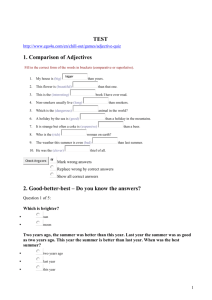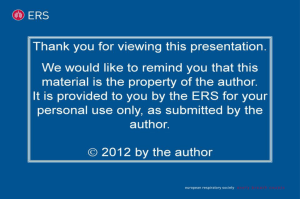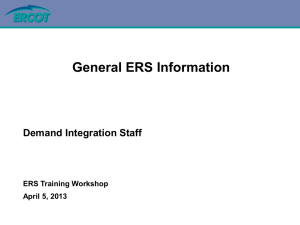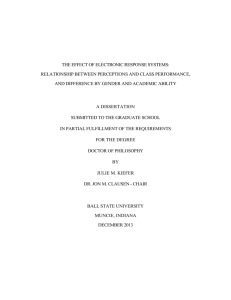6 - Manoj Rai - Overseas Development Institute
advertisement
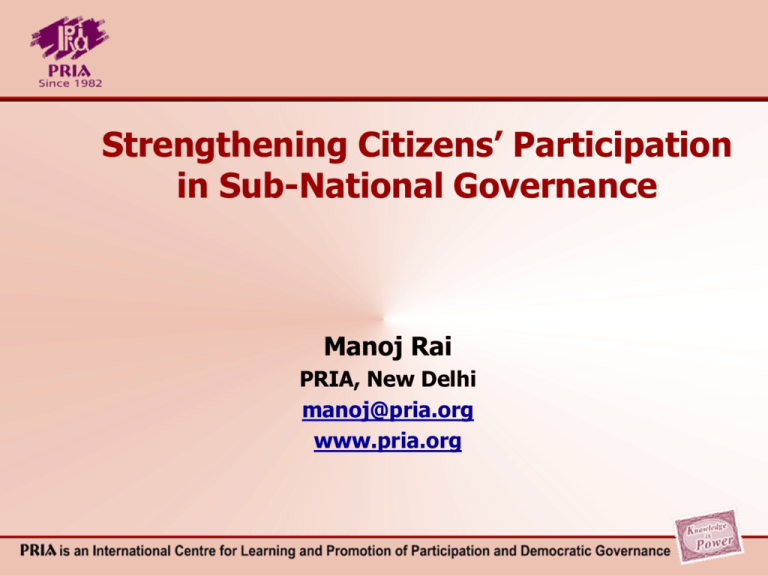
Strengthening Citizens’ Participation in Sub-National Governance Manoj Rai PRIA, New Delhi manoj@pria.org www.pria.org India: Society and Economy More than a Billion Population: Large Number of Billionaires and Largest Numbers of Poor Persons Federation of States: State of Uttar Pradesh, for example, could be ninth most populated country. Literacy rate is more than 65% but functional literacy could be quite lower. Conflicts between Legal and Social Orders: Constitutional Equalities versus Older system of Casteism and Patriarchy Dependency on Government is still very high and Bureaucracy is very powerful India: Constitutional Governance National (Union) Provincial (State) Local (District) Legislature Parliament Assembly (No. of members) (800) (4000) Panchayats/Muni cipalities (3+ Million) Conduct of 5 yearly Elections Election Commission of India State Election Commissions Subject Matter Jurisdiction Exclusive (Union List) Shared (Schedules XI and XII) Resource Sharing/Transfer Central Finance Commission Shared (State List) State Finance Commission New Opportunities through Local Governance and Older Challenges More than 3 Million Elected Representatives (ERs) mandated to lead local Economic Development with social Justice in 0.25 million (3 tier) Panchayats and about 4000 Municipalities Out of 3 plus million ERs, 1.2 million are women and about 1 million are from marginalized castes. New to political mainstream but expected to deliver in not so favorable socio-bureaucratic environment. Systems of Delivery so far has been centralized and State is still having more control over delivery mechanisms: Pace of Devolution Deliberately Slow Civil Society Organizations striving in different pockets but synergy misses many times Strengthening Citizens Participation in Local Governance to Address Poverty and Development Informed Participation in Elections: Pre Election Voters Awareness Campaigns (PEVACs) Sustained Capacity Building Supports : Quick Orientations to Newly ERs and Local Information Resource Centres (Panchayat/Municipal Resource Centres) Mobilizing Citizens Participation in Village Assemblies: Interface with and Accountability of ERs (Gram Sabha Mobilizations). Participatory Planning at Local levels linked to State and National perspectives and annual planning. Knowledge Building through Participatory Research Networking (ERs, Women, Marginalized Groups) and Advocacy for Reforming Governance Scaling Up Innovations for Institutionalization: Strategies 1. 2. 3. 4. 5. 6. Working with the Enablers: Coalition of Civil Society Organizations: Convergence and Scale Up Engaging with Governmental Institutions: Reenergizing and Complementation Partnership with Academic Institutions: Knowledge Building and Future Generation Media Partnership : Scale Up and Advocacy Working with Champions of Participation inside Government Convening, Collaborations and Complementation: Inside-Outside Roles Innovations and Scale-up: Examples Pre Election Voters Awareness Campaigns (PEVACs) 1. Platform of CSOs with common understanding and shared responsibilities, resources and common codes of conduct for State Level Coordination of a year long voters (and potential candidates) awareness campaigns: State Level Coordination Committee State Advisory Committee (comprising retired Civil Servants and Police-Judicial Officers, Academicians, Journalists on voluntary basis) to help and guide State level Coordination Committee and Liaison with State Election Commission and State Administration Division of Responsibilities among State level Coordination Committee to anchor district downward campaigns through similar setup : Posters, Pamphlets, Cable Networks, Vernacular Media, Street Plays, Small Group Meetings, Special Emphasis on Women and Other Marginalized Groups, Candidate-Electorate Interface, etc. 2. 3. Impacts of PEVACs (Studied by Academic Institutions) 1. 2. 1. 2. 3. 4. At State level: Vibrant CSOs platform covered more than 200 million citizens during 2005-06 PEVACs in 6 states. Same platform sustained to undertake similar campaigns for Capacity Building (Initial Orientations of newly ERs at large scale, Gram Sabha Mobilization, Demand generation for Right to Information and Rural Employment Guarantee Schemes) New Institutions of State Election Commissions became vibrant and responsive and received ‘public recognitions’ In intervened areas (about 53% of all Village Panchayats): Voting percentage increased by 5 – 7% Percentage of invalid votes came drastically down More educated and younger citizens, specially from marginalized sections, contested elections and won Citizens-Candidates interface during PEVAC became basis for ERs accountability to deliver his/her promises Sub District, District and State Level Networks of Women and ERs: 1. 2. 3. Multi Level and Interlinked Evolution of Bottom-up Networks of Women and Elected Representatives: Internal Capacity Building by Sharing, exchanges and sense of Solidarity among Members Collective actions and effective Occupation of New Spaces: Effective voice of women in patriarchal village assemblies, Voices against caste and gender based Discriminations and Atrocities Pressure Group, Effective Negotiations with Powers: Campaigns against female feticides in different states, Network of ERs periodically Monitoring the Devolution of Funds, Functions and Functionaries to Local Governments Overall Learning Isolated Innovations are important but they need to be scaled up and institutionalized. Convergences of Ideas and Initiatives are key to visible positive impacts. Citizen centric initiatives could take time to pick up but that’s are most effective and sustainable. It is important to work with different stakeholders and Well planned facilitations of Multi Stakeholders dialogues are often icebreakers to deadliest deadlocks. There are many champions inside the Governments who need to be supported to reform the system from inside. Convening and Resources from Government are often conditioned to influence the monitoring of governmental initiatives. So, Civil Society should be supported to sustain its freedom to play its independent and complimentary roles.
